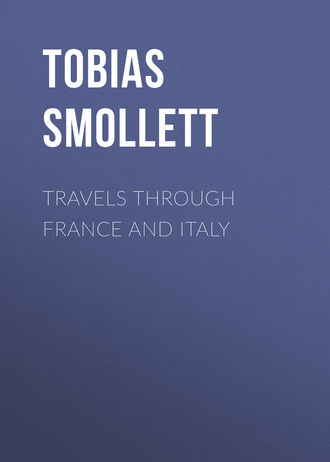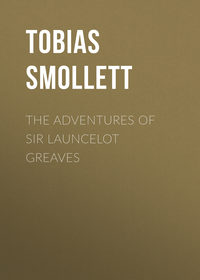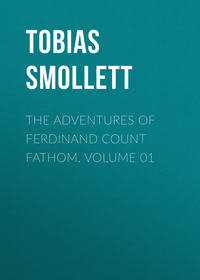 полная версия
полная версияПолная версия
Travels through France and Italy
In the cathedral, which is a large Gothic pile, [This Edifice is not absolutely Gothic. It was built in the Twelfth Century after the Design of a Greek Architect from Constantinople, where by that time the art was much degenerated. The Pillars of Granite are mostly from the Islands of Ebba and Giglia on the coast of Tuscany, where those quarries were worked by the antient Romans. The Giullo, and the verde antico are very beautiful species of marble, yellow and green; the first, antiently called marmor numidicum, came from Africa; the other was found (according to Strabo) on the mons Taygetus in Lacedemonia: but, at present, neither the one nor the other is to be had except among the ruins of antiquity.] there is a great number of massy pillars of porphyry, granite, jasper, giullo, and verde antico, together with some good pictures and statues: but the greatest curiosity is that of the brass-gates, designed and executed by John of Bologna, representing, embossed in different compartments, the history of the Old and New Testament. I was so charmed with this work, that I could have stood a whole day to examine and admire it. In the Baptisterium, which stands opposite to this front, there are some beautiful marbles, particularly the font, and a pulpit, supported by the statues of different animals.
Between the cathedral and this building, about one hundred paces on one side, is the famous burying-ground, called Campo Santo, from its being covered with earth brought from Jerusalem. It is an oblong square, surrounded by a very high wall, and always kept shut. Within-side there is a spacious corridore round the whole space, which is a noble walk for a contemplative philosopher. It is paved chiefly with flat grave-stones: the walls are painted in fresco by Ghiotto, Giottino, Stefano, Bennoti, Bufalmaco, and some others of his cotemporaries and disciples, who flourished immediately after the restoration of painting. The subjects are taken from the Bible. Though the manner is dry, the drawing incorrect, the design generally lame, and the colouring unnatural; yet there is merit in the expression: and the whole remains as a curious monument of the efforts made by this noble art immediately after her revival. [The History of Job by Giotto is much admired.] Here are some deceptions in perspective equally ingenious and pleasing; particularly the figures of certain animals, which exhibit exactly the same appearance, from whatever different points of view they are seen. One division of the burying-ground consists of a particular compost, which in nine days consumes the dead bodies to the bones: in all probability, it is no other than common earth mixed with quick-lime. At one corner of the corridore, there are the pictures of three bodies represented in the three different stages of putrefaction which they undergo when laid in this composition. At the end of the three first days, the body is bloated and swelled, and the features are enlarged and distorted to such a degree, as fills the spectator with horror. At the sixth day, the swelling is subsided, and all the muscular flesh hangs loosened from the bones: at the ninth, nothing but the skeleton remains. There is a small neat chapel at one end of the Campo Santo, with some tombs, on one of which is a beautiful bust by Buona Roti. [Here is a sumptuous cenotaph erected by Pope Gregory XIII. to the memory of his brother Giovanni Buoncampagni. It is called the Monumentum Gregorianum, of a violet-coloured marble from Scravezza in this neighbourhood, adorned with a couple of columns of Touchstone, and two beautiful spherical plates of Alabaster.] At the other end of the corridore, there is a range of antient sepulchral stones ornamented with basso-relievo brought hither from different parts by the Pisan Fleets in the course of their expeditions. I was struck with the figure of a woman lying dead on a tomb-stone, covered with a piece of thin drapery, so delicately cut as to shew all the flexures of the attitude, and even all the swellings and sinuosities of the muscles. Instead of stone, it looks like a sheet of wet linen. [One of these antiquities representing the Hunting of Meleager was converted into a coffin for the Countess Beatrice, mother of the famous Countess Mathilda; it is now fixed to the outside of the church wall just by one of the doors, and is a very elegant piece of sculpture. Near the same place is a fine pillar of Porphyry supporting the figure of a Lion, and a kind of urn which seems to be a Sarcophagus, though an inscription round the Base declares it is a Talentum in which the antient Pisans measured the Census or Tax which they payed to Augustus: but in what metal or specie this Census was payed we are left to divine. There are likewise in the Campo Santo two antique Latin edicts of the Pisan Senate injoining the citizens to go into mourning for the Death of Caius and Lucius Caesar the Sons of Agrippa, and heirs declared of the Emperor. Fronting this Cemetery, on the other side of the Piazza of the Dome, is a large, elegant Hospital in which the sick are conveniently and comfortably lodged, entertained, and attended.]
For four zechines I hired a return-coach and four from Pisa to Florence. This road, which lies along the Arno, is very good; and the country is delightful, variegated with hill and vale, wood and water, meadows and corn-fields, planted and inclosed like the counties of Middlesex and Hampshire; with this difference, however, that all the trees in this tract were covered with vines, and the ripe clusters black and white, hung down from every bough in a most luxuriant and romantic abundance. The vines in this country are not planted in rows, and propped with sticks, as in France and the county of Nice, but twine around the hedge-row trees, which they almost quite cover with their foliage and fruit. The branches of the vine are extended from tree to tree, exhibiting beautiful festoons of real leaves, tendrils, and swelling clusters a foot long. By this oeconomy the ground of the inclosure is spared for corn, grass, or any other production. The trees commonly planted for the purpose of sustaining the vines, are maple, elm, and aller, with which last the banks of the Arno abound. [It would have been still more for the advantage of the Country and the Prospect, if instead of these they had planted fruit trees for the purpose.] This river, which is very inconsiderable with respect to the quantity of water, would be a charming pastoral stream, if it was transparent; but it is always muddy and discoloured. About ten or a dozen miles below Florence, there are some marble quarries on the side of it, from whence the blocks are conveyed in boats, when there is water enough in the river to float them, that is after heavy rains, or the melting of the snow upon the mountains of Umbria, being part of the Apennines, from whence it takes its rise.
Florence is a noble city, that still retains all the marks of a majestic capital, such as piazzas, palaces, fountains, bridges, statues, and arcades. I need not tell you that the churches here are magnificent, and adorned not only with pillars of oriental granite, porphyry, Jasper, verde antico, and other precious stones; but also with capital pieces of painting by the most eminent masters. Several of these churches, however, stand without fronts, for want of money to complete the plans. It may also appear superfluous to mention my having viewed the famous gallery of antiquities, the chapel of St. Lorenzo, the palace of Pitti, the cathedral, the baptisterium, Ponte de Trinita, with its statues, the triumphal arch, and every thing which is commonly visited in this metropolis. But all these objects having been circumstantially described by twenty different authors of travels, I shall not trouble you with a repetition of trite observations.
That part of the city which stands on each side of the river, makes a very elegant appearance, to which the four bridges and the stone-quay between them, contribute in a great measure. I lodged at the widow Vanini's, an English house delightfully situated in this quarter. The landlady, who is herself a native of England, we found very obliging. The lodging-rooms are comfortable; and the entertainment is good and reasonable. There is a considerable number of fashionable people at Florence, and many of them in good circumstances. They affect a gaiety in their dress, equipage, and conversation; but stand very much on their punctilio with strangers; and will not, without great reluctance, admit into their assemblies any lady of another country, whose noblesse is not ascertained by a title. This reserve is in some measure excusable among a people who are extremely ignorant of foreign customs, and who know that in their own country, every person, even the most insignificant, who has any pretensions to family, either inherits, or assumes the title of principe, conte, or marchese.
With all their pride, however, the nobles of Florence are humble enough to enter into partnership with shop-keepers, and even to sell wine by retail. It is an undoubted fact, that in every palace or great house in this city, there is a little window fronting the street, provided with an iron-knocker, and over it hangs an empty flask, by way of sign-post. Thither you send your servant to buy a bottle of wine. He knocks at the little wicket, which is opened immediately by a domestic, who supplies him with what he wants, and receives the money like the waiter of any other cabaret. It is pretty extraordinary, that it should not be deemed a disparagement in a nobleman to sell half a pound of figs, or a palm of ribbon or tape, or to take money for a flask of sour wine; and yet be counted infamous to match his daughter in the family of a person who has distinguished himself in any one of the learned professions.
Though Florence be tolerably populous, there seems to be very little trade of any kind in it: but the inhabitants flatter themselves with the prospect of reaping great advantage from the residence of one of the arch-dukes, for whose reception they are now repairing the palace of Pitti. I know not what the revenues of Tuscany may amount to, since the succession of the princes of Lorraine; but, under the last dukes of the Medici family, they were said to produce two millions of crowns, equal to five hundred thousand pounds sterling. These arose from a very heavy tax upon land and houses, the portions of maidens, and suits at law, besides the duties upon traffick, a severe gabelle upon the necessaries of life, and a toll upon every eatable entered into this capital. If we may believe Leti, the grand duke was then able to raise and maintain an army of forty thousand infantry, and three thousand horse; with twelve gallies, two galeasses, and twenty ships of war. I question if Tuscany can maintain at present above one half of such an armament. He that now commands the emperor's navy, consisting of a few frigates, is an Englishman, called Acton, who was heretofore captain of a ship in our East India company's service. He has lately embraced the catholic religion, and been created admiral of Tuscany.
There is a tolerable opera in Florence for the entertainment of the best company, though they do not seem very attentive to the musick. Italy is certainly the native country of this art; and yet, I do not find the people in general either more musically inclined, or better provided with ears than their neighbours. Here is also a wretched troop of comedians for the burgeois, and lower class of people: but what seems most to suit the taste of all ranks, is the exhibition of church pageantry. I had occasion to see a procession, where all the noblesse of the city attended in their coaches, which filled the whole length of the great street called the Corso. It was the anniversary of a charitable institution in favour of poor maidens, a certain number of whom are portioned every year. About two hundred of these virgins walked in procession, two and two together, cloathed in violet-coloured wide gowns, with white veils on their heads, and made a very classical appearance. They were preceded and followed by an irregular mob of penitents in sack-cloth, with lighted tapers, and monks carrying crucifixes, bawling and bellowing the litanies: but the great object was a figure of the Virgin Mary, as big as the life, standing within a gilt frame, dressed in a gold stuff, with a large hoop, a great quantity of false jewels, her face painted and patched, and her hair frizzled and curled in the very extremity of the fashion. Very little regard had been paid to the image of our Saviour on the cross; but when his lady-mother appeared on the shoulders of three or four lusty friars, the whole populace fell upon their knees in the dirt. This extraordinary veneration paid to the Virgin, must have been derived originally from the French, who pique themselves on their gallantry to the fair sex.
Amidst all the scenery of the Roman catholic religion, I have never yet seen any of the spectators affected at heart, or discover the least signs of fanaticism. The very disciplinants, who scourge themselves in the Holy-week, are generally peasants or parties hired for the purpose. Those of the confrairies, who have an ambition to distinguish themselves on such occasions, take care to secure their backs from the smart, by means of secret armour, either women's boddice, or quilted jackets. The confrairies are fraternities of devotees, who inlist themselves under the banners of particular saints. On days of procession they appear in a body dressed as penitents and masked, and distinguished by crosses on their habits. There is scarce an individual, whether noble or plebeian, who does not belong to one of these associations, which may be compared to the FreeMasons, Gregoreans, and Antigallicans of England.
Just without one of the gates of Florence, there is a triumphal arch erected on occasion of the late emperor's making his public entry, when he succeeded to the dukedom of Tuscany: and herein the summer evenings, the quality resort to take the air in their coaches. Every carriage stops, and forms a little separate conversazione. The ladies sit within, and the cicisbei stand on the foot-boards, on each side of the coach, entertaining them with their discourse. It would be no unpleasant inquiry to trace this sort of gallantry to its original, and investigate all its progress. The Italians, having been accused of jealousy, were resolved to wipe off the reproach, and, seeking to avoid it for the future, have run into the other extreme. I know it is generally supposed that the custom of choosing cicisbei, was calculated to prevent the extinction of families, which would otherwise often happen in consequence of marriages founded upon interest, without any mutual affection in the contracting parties. How far this political consideration may have weighed against the jealous and vindictive temper of the Italians, I will not pretend to judge: but, certain it is, every married lady in this country has her cicisbeo, or servente, who attends her every where, and on all occasions; and upon whose privileges the husband dares not encroach, without incurring the censure and ridicule of the whole community. For my part, I would rather be condemned for life to the gallies, than exercise the office of a cicisbeo, exposed to the intolerable caprices and dangerous resentment of an Italian virago. I pretend not to judge of the national character, from my own observation: but, if the portraits drawn by Goldoni in his Comedies are taken from nature, I would not hesitate to pronounce the Italian women the most haughty, insolent, capricious, and revengeful females on the face of the earth. Indeed their resentments are so cruelly implacable, and contain such a mixture of perfidy, that, in my opinion, they are very unfit subjects for comedy, whose province it is, rather to ridicule folly than to stigmatize such atrocious vice.
You have often heard it said, that the purity of the Italian is to be found in the lingua Toscana, and bocca Romana. Certain it is, the pronunciation of the Tuscans is disagreeably guttural: the letters C and G they pronounce with an aspiration, which hurts the ear of an Englishman; and is I think rather rougher than that of the X, in Spanish. It sounds as if the speaker had lost his palate. I really imagined the first man I heard speak in Pisa, had met with that misfortune in the course of his amours.
One of the greatest curiosities you meet with in Italy, is the Improvisatore; such is the name given to certain individuals, who have the surprising talent of reciting verses extempore, on any subject you propose. Mr. Corvesi, my landlord, has a son, a Franciscan friar, who is a great genius in this way.
When the subject is given, his brother tunes his violin to accompany him, and he begins to rehearse in recitative, with wonderful fluency and precision. Thus he will, at a minute's warning, recite two or three hundred verses, well turned, and well adapted, and generally mingled with an elegant compliment to the company. The Italians are so fond of poetry, that many of them, have the best part of Ariosto, Tasso, and Petrarch, by heart; and these are the great sources from which the Improvisatori draw their rhimes, cadence, and turns of expression. But, lest you should think there is neither rhime nor reason in protracting this tedious epistle, I shall conclude it with the old burden of my song, that I am always—Your affectionate humble servant.
LETTER XXVIII
NICE, February 5, 1765.DEAR SIR,—Your entertaining letter of the fifth of last month, was a very charitable and a very agreeable donation: but your suspicion is groundless. I assure you, upon my honour, I have no share whatever in any of the disputes which agitate the public: nor do I know any thing of your political transactions, except what I casually see in one of your newspapers, with the perusal of which I am sometimes favoured by our consul at Villefranche. You insist upon my being more particular in my remarks on what I saw at Florence, and I shall obey the injunction. The famous gallery which contains the antiquities, is the third story of a noble stone-edifice, built in the form of the Greek Pi, the upper part fronting the river Arno, and one of the legs adjoining to the ducal-palace, where the courts of justice are held. As the house of Medici had for some centuries resided in the palace of Pitti, situated on the other side of the river, a full mile from these tribunals, the architect Vasari, who planned the new edifice, at the same time contrived a corridore, or covered passage, extending from the palace of Pitti along one of the bridges, to the gallery of curiosities, through which the grand-duke passed unseen, when he was disposed either to amuse himself with his antiquities, or to assist at his courts of judicature: but there is nothing very extraordinary either in the contrivance or execution of this corridore.
If I resided in Florence I would give something extraordinary for permission to walk every day in the gallery, which I should much prefer to the Lycaeum, the groves of Academus, or any porch or philosophical alley in Athens or in Rome. Here by viewing the statues and busts ranged on each side, I should become acquainted with the faces of all the remarkable personages, male and female, of antiquity, and even be able to trace their different characters from the expression of their features. This collection is a most excellent commentary upon the Roman historians, particularly Suetonius and Dion Cassius. There was one circumstance that struck me in viewing the busts of Caracalla, both here and in the Capitol at Rome; there was a certain ferocity in the eyes, which seemed to contradict the sweetness of the other features, and remarkably justified the epithet Caracuyl, by which he was distinguished by the antient inhabitants of North-Britain. In the language of the Highlanders caracuyl signifies cruel eye, as we are given to understand by the ingenious editor of Fingal, who seems to think that Caracalla is no other than the Celtic word, adapted to the pronunciation of the Romans: but the truth is, Caracalla was the name of a Gaulish vestment, which this prince affected to wear; and hence he derived that surname. The Caracuyl of the Britons, is the same as the upodra idon of the Greeks, which Homer has so often applied to his Scolding Heroes. I like the Bacchanalian, chiefly for the fine drapery. The wind, occasioned by her motion, seems to have swelled and raised it from the parts of the body which it covers. There is another gay Bacchanalian, in the attitude of dancing, crowned with ivy, holding in her right hand a bunch of grapes, and in her left the thyrsus. The head of the celebrated Flora is very beautiful: the groupe of Cupid and Psyche, however, did not give me all the pleasure I expected from it.
Of all the marbles that appear in the open gallery, the following are those I most admire. Leda with the Swan; as for Jupiter, in this transformation, he has much the appearance of a goose. I have not seen any thing tamer; but the sculptor has admirably shewn his art in representing Leda's hand partly hid among the feathers, which are so lightly touched off, that the very shape of the fingers are seen underneath. The statue of a youth, supposed to be Ganymede, is compared by the connoisseurs to the celebrated Venus, and as far as I can judge, not without reason: it is however, rather agreeable than striking, and will please a connoisseur much more than a common spectator. I know not whether it is my regard to the faculty that inhances the value of the noted Esculapius, who appears with a venerable beard of delicate workmanship. He is larger than the life, cloathed in a magnificent pallium, his left arm resting on a knotted staff, round which the snake is twined according to Ovid.
Hunc modo serpentem baculum qui nexibus ambit Perspice—
Behold the snake his mystic Rod intwine.
He has in his hand the fascia herbarum, and the crepidae on his feet. There is a wild-boar represented lying on one side, which I admire as a master-piece. The savageness of his appearance is finely contrasted with the case and indolence of the attitude. Were I to meet with a living boar lying with the same expression, I should be tempted to stroke his bristles. Here is an elegant bust of Antinous, the favourite of Adrian; and a beautiful head of Alexander the Great, turned on one side, with an expression of languishment and anxiety in his countenance. The virtuosi are not agreed about the circumstance in which he is represented; whether fainting with the loss of blood which he suffered in his adventure at Oxydrace; or languishing with the fever contracted by bathing in the Cydnus; or finally complaining to his father Jove, that there were no other worlds for him to conquer. The kneeling Narcissus is a striking figure, and the expression admirable. The two Bacchi are perfectly well executed; but (to my shame be it spoken) I prefer to the antique that which is the work of Michael Angelo Buonaroti, concerning which the story is told which you well know. The artist having been blamed by some pretended connoisseurs, for not imitating the manner of the ancients, is said to have privately finished this Bacchus, and buried it, after having broke off an arm, which he kept as a voucher. The statue, being dug up by accident, was allowed by the best judges, to be a perfect antique; upon which Buonaroti produced the arm, and claimed his own work. Bianchi looks upon this as a fable; but owns that Vasari tells such another of a child cut in marble by the same artist, which being carried to Rome, and kept for some time under ground, was dug up as an antique, and sold for a great deal of money. I was likewise attracted by the Morpheus in touchstone, which is described by Addison, who, by the bye, notwithstanding all his taste, has been convicted by Bianchi of several gross blunders in his account of this gallery.
With respect to the famous Venus Pontia, commonly called de Medicis, which was found at Tivoli, and is kept in a separate apartment called the Tribuna, I believe I ought to be intirely silent, or at least conceal my real sentiments, which will otherwise appear equally absurd and presumptuous. It must be want of taste that prevents my feeling that enthusiastic admiration with which others are inspired at sight of this statue: a statue which in reputation equals that of Cupid by Praxiteles, which brought such a concourse of strangers of old to the little town of Thespiae. I cannot help thinking that there is no beauty in the features of Venus; and that the attitude is aukward and out of character. It is a bad plea to urge that the antients and we differ in the ideas of beauty. We know the contrary, from their medals, busts, and historians. Without all doubt, the limbs and proportions of this statue are elegantly formed, and accurately designed, according to the nicest rules of symmetry and proportion; and the back parts especially are executed so happily, as to excite the admiration of the most indifferent spectator. One cannot help thinking it is the very Venus of Cnidos by Praxiteles, which Lucian describes. "Hercle quanta dorsi concinnitas! ut exuberantes lumbi amplexantes manus implent! quam scite circumductae clunium pulpae in se rotundantur, neque tenues nimis ipsis ossibus adstrictae, neque in immensam effusae Pinguedinem!" That the statue thus described was not the Venus de Medicis, would appear from the Greek inscription on the base, KLEOMENIS APPOLLODOROI ATHINAIOS EPOESEI. Cleomenes filius Apollodori fecit; did we not know that this inscription is counted spurious, and that instead of EPOESEI, it should be EPOIESE. This, however, is but a frivolous objection, as we have seen many inscriptions undoubtedly antique, in which the orthography is false, either from the ignorance or carelessness of the sculptor. Others suppose, not without reason, that this statue is a representation of the famous Phryne, the courtesan of Athens, who at the celebration of the Eleusinian games, exhibited herself coming out of the bath, naked, to the eyes of the whole Athenian people. I was much pleased with the dancing faun; and still better with the Lotti, or wrestlers, the attitudes of which are beautifully contrived to shew the different turns of the limbs, and the swelling of the muscles: but, what pleased me best of all the statues in the Tribuna was the Arrotino, commonly called the Whetter, and generally supposed to represent a slave, who in the act of whetting a knife, overhears the conspiracy of Catiline. You know he is represented on one knee; and certain it is, I never saw such an expression of anxious attention, as appears in his countenance. But it is not mingled with any marks of surprise, such as could not fail to lay hold on a man who overhears by accident a conspiracy against the state. The marquis de Maffei has justly observed that Sallust, in his very circumstantial detail of that conspiracy, makes no mention of any such discovery. Neither does it appear that the figure is in the act of whetting, the stone which he holds in one hand being rough and unequal no ways resembling a whetstone. Others alledge it represents Milico, the freedman of Scaevinus, who conspired against the life of Nero, and gave his poignard to be whetted to Milico, who presented it to the emperor, with an account of the conspiracy: but the attitude and expression will by no means admit of this interpretation. Bianchi, [This antiquarian is now imprisoned for Life, for having robbed the Gallery and then set it on fire.] who shows the gallery, thinks the statue represents the augur Attius Navius, who cut a stone with a knife, at the command of Tarquinius Priscus. This conjecture seems to be confirmed by a medallion of Antoninus Pius, inserted by Vaillant among his Numismata Prestantiora, on which is delineated nearly such a figure as this in question, with the following legend. "Attius Navius genuflexus ante Tarquinium Priscum cotem cultro discidit." He owns indeed that in the statue, the augur is not distinguished either by his habit or emblems; and he might have added, neither is the stone a cotes. For my own part, I think neither of these three opinions is satisfactory, though the last is very ingenious. Perhaps the figure allude to a private incident, which never was recorded in any history. Among the great number of pictures in this Tribuna, I was most charmed with the Venus by Titian, which has a sweetness of expression and tenderness of colouring, not to be described. In this apartment, they reckon three hundred pieces, the greatest part by the best masters, particularly by Raphael, in the three manners by which he distinguished himself at different periods of his life. As for the celebrated statue of the hermaphrodite, which we find in another room, I give the sculptor credit for his ingenuity in mingling the sexes in the composition; but it is, at best, no other than a monster in nature, which I never had any pleasure in viewing: nor, indeed, do I think there was much talent required in representing a figure with the head and breasts of a woman, and all the other parts of the body masculine. There is such a profusion of curiosities in this celebrated musaeum; statues, busts, pictures, medals, tables inlaid in the way of marquetry, cabinets adorned with precious stones, jewels of all sorts, mathematical instruments, antient arms and military machines, that the imagination is bewildered, and a stranger of a visionary turn, would be apt to fancy himself in a palace of the fairies, raised and adorned by the power of inchantment.










